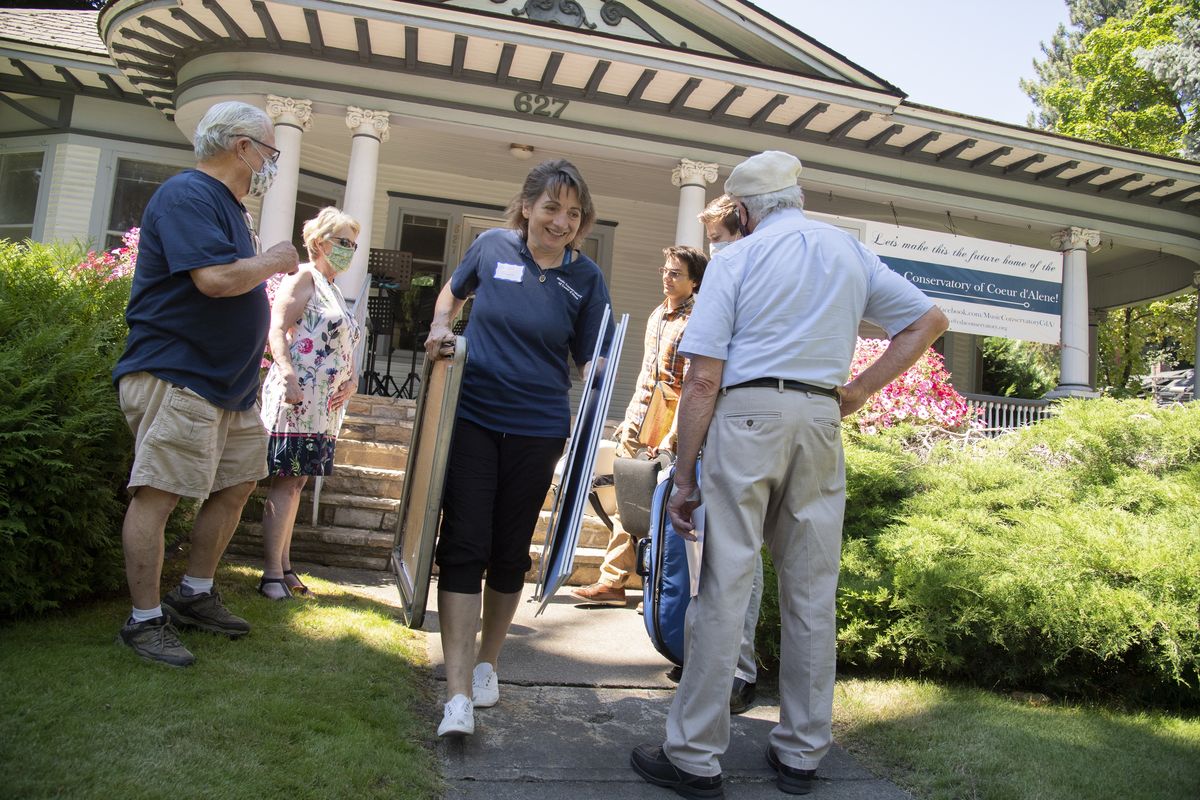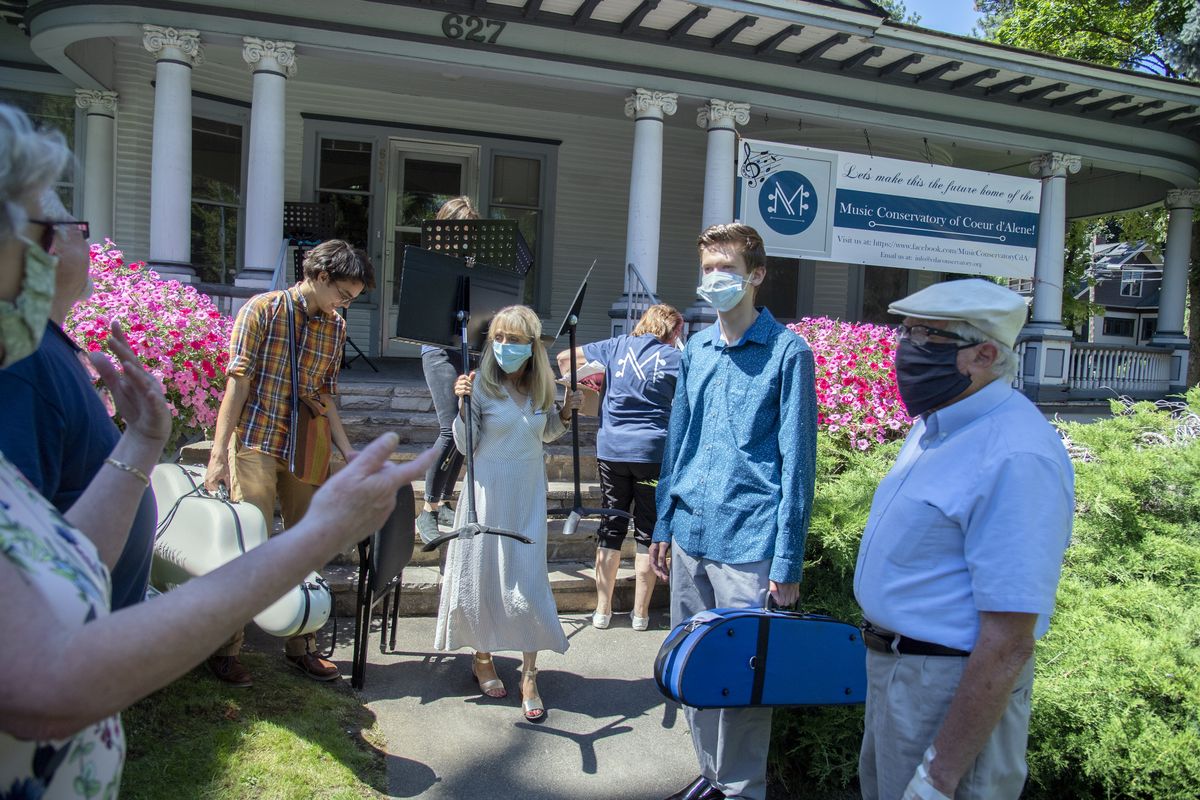Groups hopes to save historic Coeur d’Alene home through music

On a hot Monday afternoon, the Hamilton House was filled with music, as it has been.
The stately old house at 627 N. Government Way in Coeur d’Alene was built in 1908 for the city’s second mayor, Boyd Hamilton, and his wife, Alta.
Though it sits 40 minutes or so away, the Hamilton House has deep ties to Spokane – Alta was the daughter of J.J. Browne, whose name now covers an entire Spokane neighborhood, and its architect George Keith was responsible for many Spokane landmarks, including the Hutton House at 2206 E. 17th Ave. and the Royal Riblet estate that overlooks Spokane Valley.
The Hamilton House was home to a series of local celebrities throughout its century-plus lifetime, from an Idaho Supreme Court justice to world-renowned pianist Dean Elder and soprano soloist Agnes Hawkins, historian Deborah Mitchell said. It was a law office from 1975 to 2017. When it became vacant, Kootenai County planned to tear the old house down to make way for a four-story county office building.

Mitchell’s research helped prove the house’s historical significance to the city, saving it from destruction temporarily. But if something better doesn’t come along, the building will be bulldozed.
Now, an effort is underway to save the old Hamilton House and transform it into an institution fitting for its long, musical history. If all goes according to plan, the house on Government Way will become the Music Conservatory of Coeur d’Alene.
In the 102 years since it was built, the house has attracted a series of lawyers and judges, but also musicians, opera singers and their talented social circles, Mitchell, who also sits on the conservatory’s board, said. The hope now is to keep filling the Hamilton House with music into the future.
To save the house, the board needs to raise $500,000 to purchase it from the county, said Julienne Dance, the conservatory’s founder. The board received nonprofit status in June and is now crowdsourcing money for a down payment on the house through GoFundMe, but is banking its hopes on a capital campaign. Ideally, a local philanthropist or music lover would buy the house for the conservatory, saving it from destruction, Dance said.
“I had the vision for a conservatory here first about a year ago, and then I read about this house and I just knew it would work,” Dance said. “But if we don’t end up saving it, the county commissioners are sure it’s set for demolition.”
The pandemic has caused some difficulties in raising the money needed, Dance said, not only from small dollar individual donors but from would-be philanthropists who now find themselves struggling too. The GoFundMe campaign has only raised about $1,600 toward its $10,000 goal, and finding large donors has proved difficult.
Dance said she’d heard from a wealthy North Idahoan who wanted make a sizable contribution to the project, but is now unable to donate unless the pandemic-related economic turmoil relents.
“Unfortunately, even the rich are down on their luck,” Dance said.
At an invitation-only open house on Monday, Dance offered tours of the house to potential donors. Each old bedroom, parlor and dining room has a designated purpose with signs bearing musical names like the Con Brio, Adagio and Sostenuto Rooms. They sit empty now, but the hope is eventually they will echo with the sounds of piano, wind and string instruments and the voices of a choir during private lessons for adults and children of all ages and abilities.
As Coeur d’Alene and surrounding North Idaho communities have grown in recent years, music lovers have seen the need for a conservatory, said Karin Wedemeyer, director of the Music Conservatory in Sandpoint. She founded the school in 2009 hoping to add to the small city’s musical culture, starting with only eight students and two teachers. The Sandpoint school is now an accredited “trade school for music,” Wedemeyer said, with 500 students and 19 teachers.
“I want to mentor the Coeur d’Alene conservatory to the highest degree I possibly can, because we’ve seen how richly it has paid off in Sandpoint,” Wedemeyer said.
A conservatory in Coeur d’Alene not only has the potential to expand the minds of those who attend, Wedemeyer said, but the entire surrounding community through concerts, recitals and events the school might put on.
The conservatory approach is often seen as a “East or West Coast, European kind of thing,” somewhat foreign to the Inland Northwest, said Wedemeyer, who emigrated from Germany to found the school in Sandpoint. But as Sandpoint’s conservatory has bloomed, she thinks it’s proven the potential for musical excellence in North Idaho.
“If we can save the Hamilton House and turn it into something so beautiful, it’s only winning for everyone involved,” Wedemeyer said. “If it’s torn down, the whole community loses – not just a wonderful old house, but so much potential.”
In the former dining room below, cellist Matthias Aranden and violinist Jacob Unruh played a duet. Neither is a students, just “lovers of music” who want to help the conservatory any way they can, said Unruh.
The strings’ echoes could be heard in any room of the house, making the music impossible to escape. But that’s part of what makes the Hamilton House perfect for their vision, said Zoe Anne Thruman, a conservatory board member and head of the Government Way Historic Neighborhood Coalition.
“Having infinite instruments and voices playing all at once throughout the house doesn’t impede concentration, it serves to heighten the creative process,” Thruman said. “We don’t want to do any soundproofing.”
Despite the challenges of fundraising and organizing during this time, Wedemeyer said she strongly believes in the conservatory’s mission and in its ability to reach its goal.
“This is a chance to show what Coeur d’Alene is proud of,” Wedemeyer said. “It might be a hard time but we cannot just stop breathing. This is what creates hope. Self-expression is the antidote to self-destruction, and this is how we articulate our feelings in our darkest moments.”